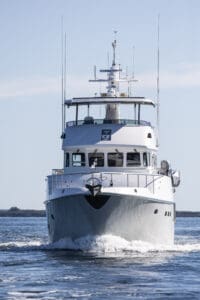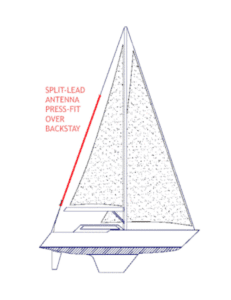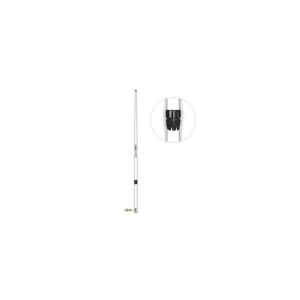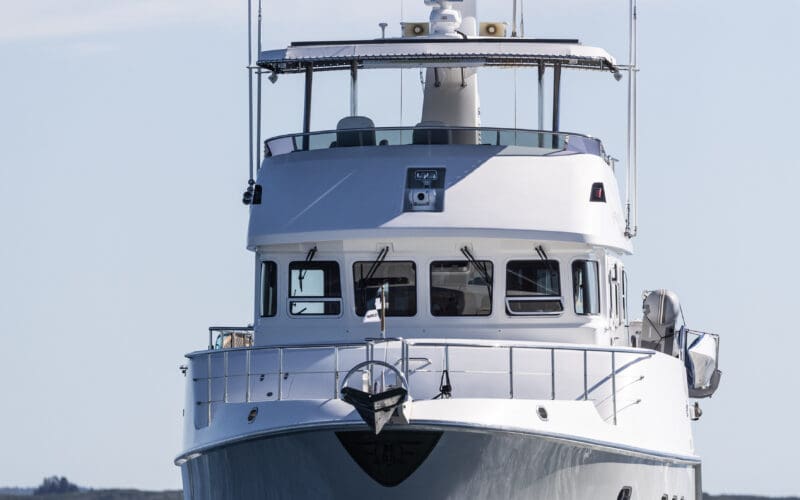by Bill Morris
 If you have chosen to install a single-sideband (SSB) transceiver with an automatic tuner on your vessel, you will also need to install an antenna system capable of transmitting and receiving from 0.5 to 30 MHz, come rain or shine anywhere on the world’s oceans.
If you have chosen to install a single-sideband (SSB) transceiver with an automatic tuner on your vessel, you will also need to install an antenna system capable of transmitting and receiving from 0.5 to 30 MHz, come rain or shine anywhere on the world’s oceans.
On sailing vessels less than roughly 50 feet LOA, the common practice is to install a backstay antenna. This requires removing the backstay, cutting out a long piece of the wire and reinstalling it with insulators to ensure transmitted power is kept safely above the heads and hands of crew.
Another approach is to use the GAM Electronics Split Lead Antenna, which can be press fit over a backstay without the need for insulators.

Owners of larger sailboats and power voyaging yachts, however, often opt for a whip antenna, which can be serviced or reinstalled at a different location. For sailboats this means the sailing rig needn’t be changed. With careful planning, your ham or marine SSB whip antenna may be mounted at a safe location away from the hands of crew and passengers. Otherwise, a 100-watt radio transmission could fry an errant hand snatching a hand hold while in rough seas.
Digital Antenna of Sunrise, Florida, offers two sizes of SSB whip antennas: a 16-foot antenna composed of two eight-foot elements and a 24-footer composed of three eight-foot elements. Both antennas accept up to 1,000 watts of transmitted power, and both are available in either a black or white finish.
The connectors at the section ends and screw mounts of the antennas are 316 stainless steel, ensuring a long life, even while exposed to constant ocean spray. The screw mount is a standard one-inch thread for easy pairing with an existing mounting device.

Also available from Digital Antenna is a 16-foot SSB antenna with a RUPP connector, a plastic collar midway up the lower antenna section allowing the antenna to be affixed to a stabilizing side mount, which may be attached to the pilot house or other permanent structure.
Digital Antenna’s two-part RUPP collar antennas are available for roughly $1,000, and their standard two-part antennas are available for about $600.
Shakespeare, a name familiar to all of us ocean sailors, offers its Model 393 antenna, a 23-foot, three-section antenna rated at 1,000 watts max output, a bit long for most sailing craft, but still a good choice for very large vessels 60 feet LOA or longer. Again, a long whip antenna would appear to be a superior alternative to hunting down a pair of backstay insulators for one-and-a-half inch rigging wire on an Oyster 100. Priced at less than $400, the Model 393 antenna comes with a two-year limited warranty.
Two different mounting systems, the Shakespeare 409R for deck mounting and the 410R for side mounting, available at extra cost, will ensure your antenna installation accommodates your deck and house configuration.
The Glomex Pro Marine series PRA703 is also a three-section fiberglass SSB antenna suitable for larger yachts and commercial vessels. This antenna system’s power rating is 800 watts, a bit shy of the capacity of other antennas in this class, but probably more than you will ever need. Most ham and SSB radios are limited to 100 watts peak envelope power (PEP), so the PRA703 offers far more transmission than necessary. When we look at the unit’s price, roughly $160, it’s hard to imagine a better bargain for a marine SSB antenna.
While most of us cruisers are happy with our backstay insulators from Sta-Lok, Ronstan or Hayn Hi-MOD, you guys on the big boats can stay in the conversation with a whip antenna that more than meets your needs.
Circumnavigator/author Bill Morris believes the best strategy for succeeding as an offshore voyager is to keep systems simple and, if possible, manual. Key to survival are a windvane self-steering system, a basic array of electronics and an aggressive alternative energy battery charging matrix. Bill is an Ocean Navigator contributing editor and the author of The Windvane Self-Steering Handbook (International Marine, 2004) and The Captain’s Guide to Alternative Energy Afloat (Seaworthy Publications, 2019).

